Abstract
BACKGROUND: Overnight polysomnography is expensive and time consuming. An approach based on a logistic regression model and overnight pulse oximetry has been developed to determine which of the snorers referred to our sleep laboratory need polysomnography. METHODS: The variables entered in the regression model were derived from questionnaires completed by 95 habitual snorers and 89 patients with obstructive sleep apnoea. The resulting regression equation included weight, height, sex, witnessed episodes of apnoea, and reports of falling asleep when reading. This prediction equation was applied to a sample of 116 consecutive patients referred for investigation of heavy snoring. Pulse oximetry data on the 116 test subjects were obtained during polysomnography and analysed separately. Pulse oximetry was judged to indicate obstructive sleep apnoea when it showed cyclic oscillations of oxyhaemoglobin saturation or heart rate, or both, for more than 30 minutes during the study night. RESULTS: A cut off probability of 0.31 gave the prediction model a sensitivity of 94% to predict an apnoea-hypopnoea index above 10, with a specificity of 45%. When this cutoff point was used to predict an apnoea-hypopnoea index of over 20 sensitivity was 95% and specificity 41%. Combined with oximetry our regression model had a sensitivity of 100% for predicting an apnoea-hypopnoea index of more than 10. On the other hand, all patients with negative results from oximetry and a probability value below 0.31 had an apnoea-hypopnoea index lower than 10 according to polysomnography. CONCLUSIONS: It is concluded that snorers with negative results from oximetry classified as not having obstructive sleep apnoea according to this model do not need polysomnography.
Full text
PDF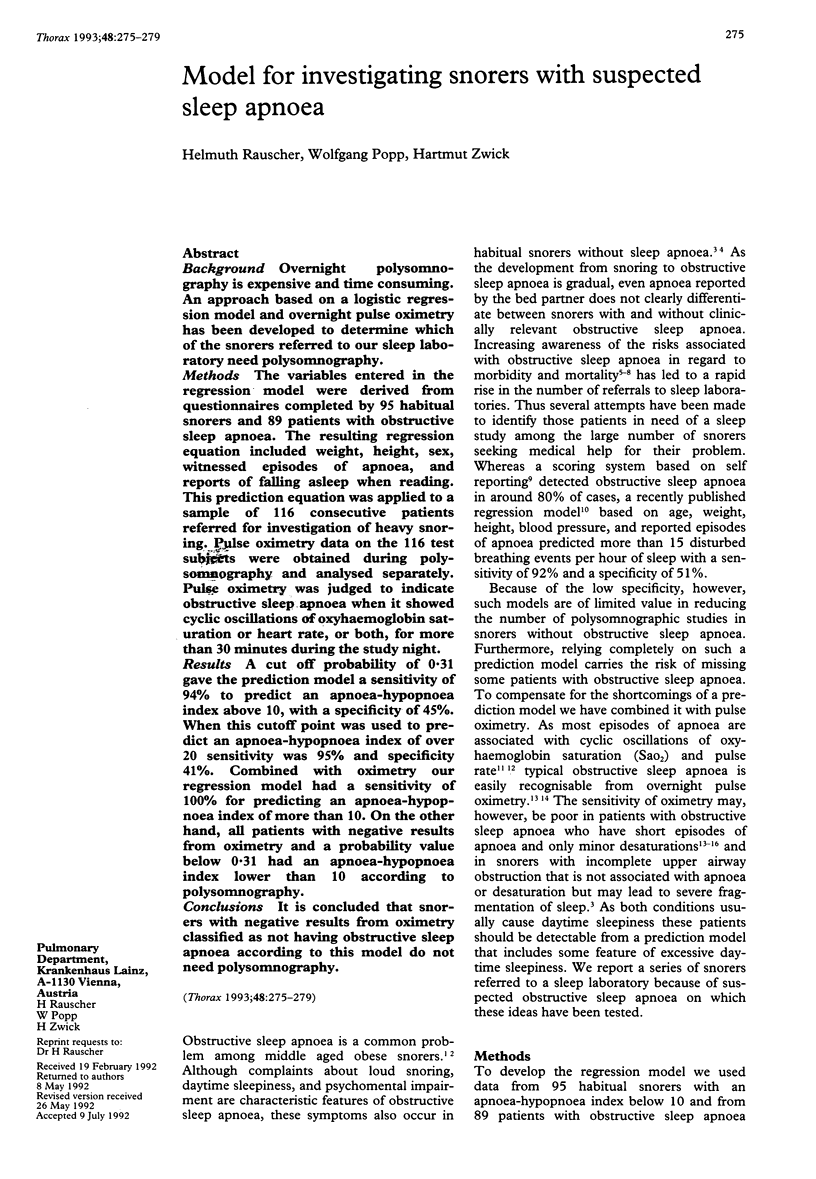
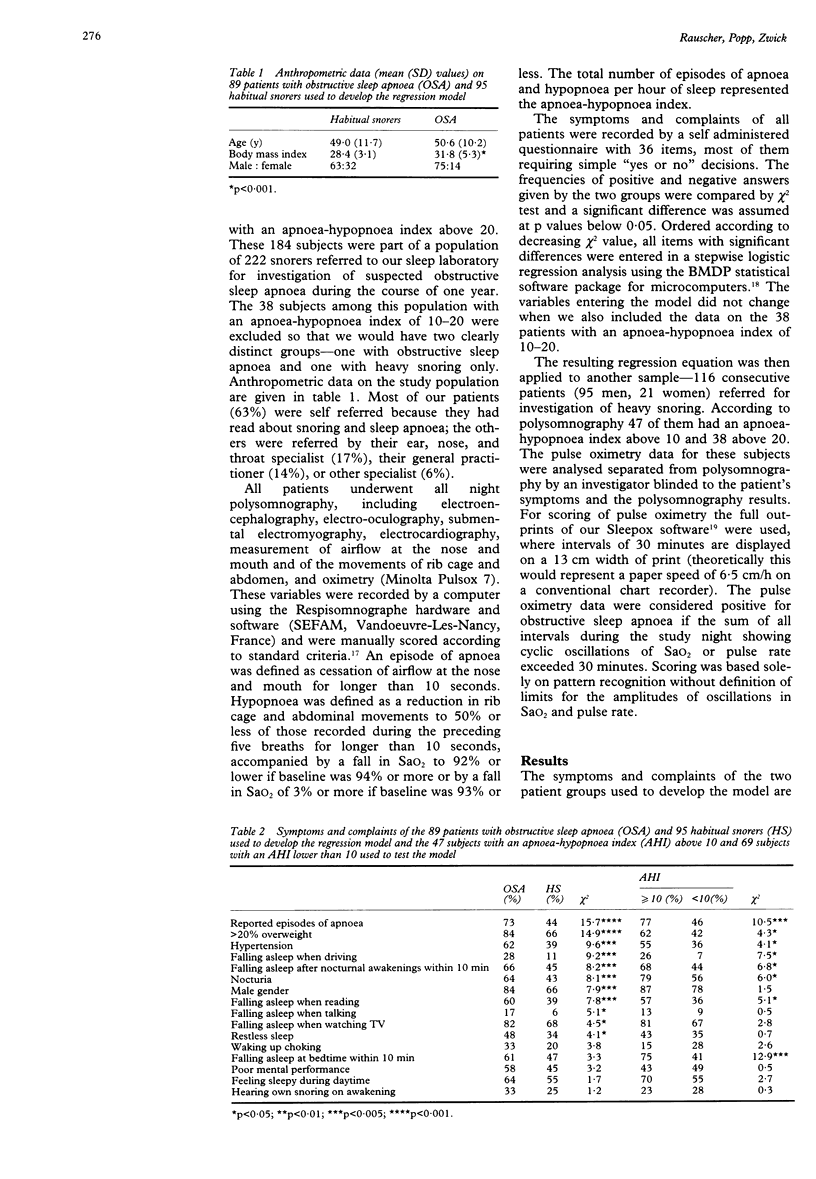
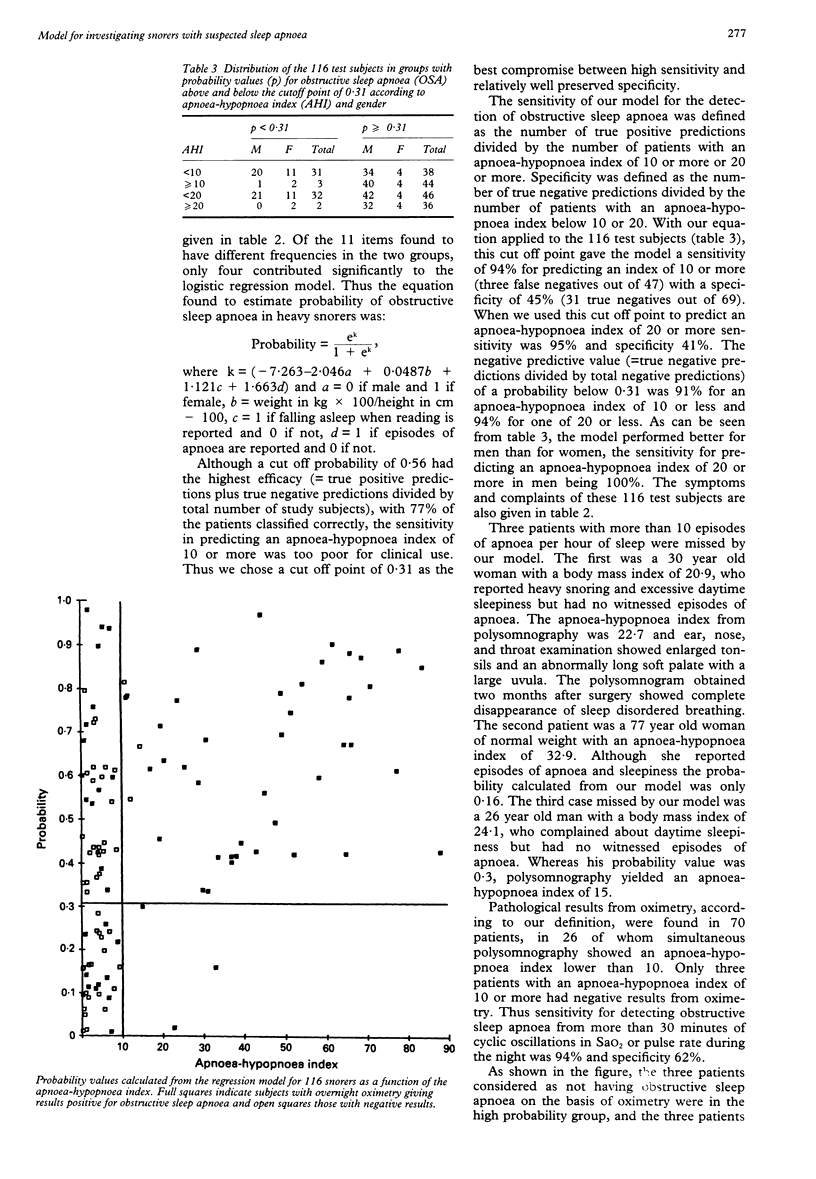
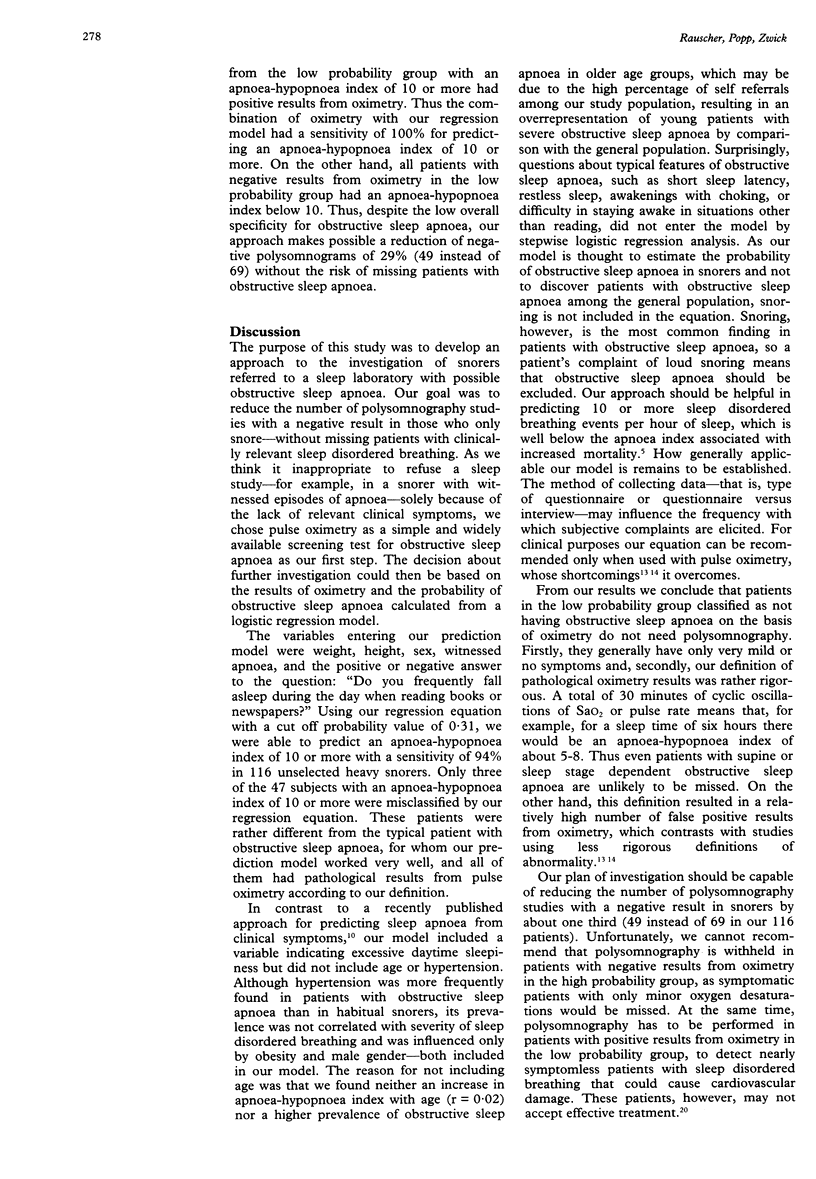
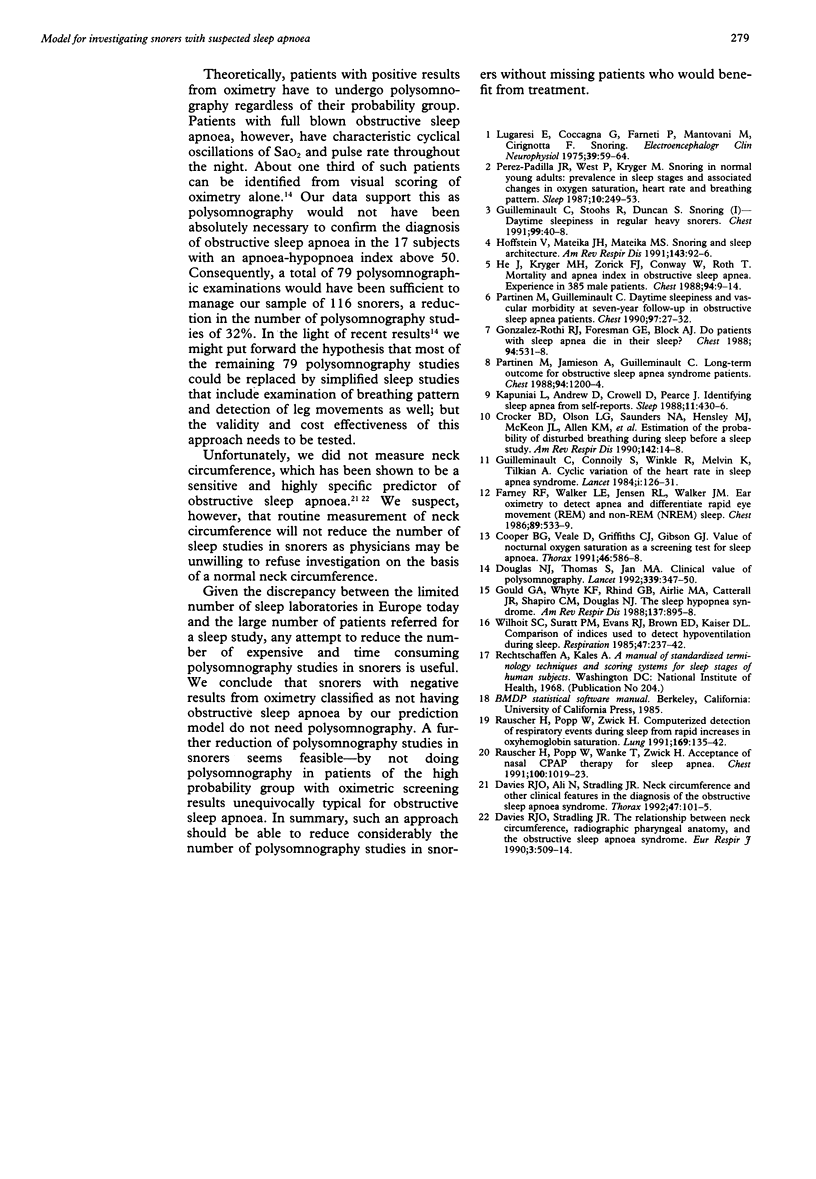
Selected References
These references are in PubMed. This may not be the complete list of references from this article.
- Cooper B. G., Veale D., Griffiths C. J., Gibson G. J. Value of nocturnal oxygen saturation as a screening test for sleep apnoea. Thorax. 1991 Aug;46(8):586–588. doi: 10.1136/thx.46.8.586. [DOI] [PMC free article] [PubMed] [Google Scholar]
- Crocker B. D., Olson L. G., Saunders N. A., Hensley M. J., McKeon J. L., Allen K. M., Gyulay S. G. Estimation of the probability of disturbed breathing during sleep before a sleep study. Am Rev Respir Dis. 1990 Jul;142(1):14–18. doi: 10.1164/ajrccm/142.1.14. [DOI] [PubMed] [Google Scholar]
- Davies R. J., Ali N. J., Stradling J. R. Neck circumference and other clinical features in the diagnosis of the obstructive sleep apnoea syndrome. Thorax. 1992 Feb;47(2):101–105. doi: 10.1136/thx.47.2.101. [DOI] [PMC free article] [PubMed] [Google Scholar]
- Davies R. J., Stradling J. R. The relationship between neck circumference, radiographic pharyngeal anatomy, and the obstructive sleep apnoea syndrome. Eur Respir J. 1990 May;3(5):509–514. [PubMed] [Google Scholar]
- Douglas N. J., Thomas S., Jan M. A. Clinical value of polysomnography. Lancet. 1992 Feb 8;339(8789):347–350. doi: 10.1016/0140-6736(92)91660-z. [DOI] [PubMed] [Google Scholar]
- Farney R. J., Walker L. E., Jensen R. L., Walker J. M. Ear oximetry to detect apnea and differentiate rapid eye movement (REM) and non-REM (NREM) sleep. Screening for the sleep apnea syndrome. Chest. 1986 Apr;89(4):533–539. doi: 10.1378/chest.89.4.533. [DOI] [PubMed] [Google Scholar]
- Gonzalez-Rothi R. J., Foresman G. E., Block A. J. Do patients with sleep apnea die in their sleep? Chest. 1988 Sep;94(3):531–538. doi: 10.1378/chest.94.3.531. [DOI] [PubMed] [Google Scholar]
- Gould G. A., Whyte K. F., Rhind G. B., Airlie M. A., Catterall J. R., Shapiro C. M., Douglas N. J. The sleep hypopnea syndrome. Am Rev Respir Dis. 1988 Apr;137(4):895–898. doi: 10.1164/ajrccm/137.4.895. [DOI] [PubMed] [Google Scholar]
- Guilleminault C., Connolly S., Winkle R., Melvin K., Tilkian A. Cyclical variation of the heart rate in sleep apnoea syndrome. Mechanisms, and usefulness of 24 h electrocardiography as a screening technique. Lancet. 1984 Jan 21;1(8369):126–131. doi: 10.1016/s0140-6736(84)90062-x. [DOI] [PubMed] [Google Scholar]
- Guilleminault C., Stoohs R., Duncan S. Snoring (I). Daytime sleepiness in regular heavy snorers. Chest. 1991 Jan;99(1):40–48. doi: 10.1378/chest.99.1.40. [DOI] [PubMed] [Google Scholar]
- He J., Kryger M. H., Zorick F. J., Conway W., Roth T. Mortality and apnea index in obstructive sleep apnea. Experience in 385 male patients. Chest. 1988 Jul;94(1):9–14. [PubMed] [Google Scholar]
- Hoffstein V., Mateika J. H., Mateika S. Snoring and sleep architecture. Am Rev Respir Dis. 1991 Jan;143(1):92–96. doi: 10.1164/ajrccm/143.1.92. [DOI] [PubMed] [Google Scholar]
- Kapuniai L. E., Andrew D. J., Crowell D. H., Pearce J. W. Identifying sleep apnea from self-reports. Sleep. 1988 Oct;11(5):430–436. doi: 10.1093/sleep/11.5.430. [DOI] [PubMed] [Google Scholar]
- Lugaresi E. Snoring. Electroencephalogr Clin Neurophysiol. 1975 Jul;39(1):59–64. doi: 10.1016/0013-4694(75)90127-3. [DOI] [PubMed] [Google Scholar]
- Partinen M., Guilleminault C. Daytime sleepiness and vascular morbidity at seven-year follow-up in obstructive sleep apnea patients. Chest. 1990 Jan;97(1):27–32. doi: 10.1378/chest.97.1.27. [DOI] [PubMed] [Google Scholar]
- Partinen M., Jamieson A., Guilleminault C. Long-term outcome for obstructive sleep apnea syndrome patients. Mortality. Chest. 1988 Dec;94(6):1200–1204. doi: 10.1378/chest.94.6.1200. [DOI] [PubMed] [Google Scholar]
- Perez-Padilla J. R., West P., Kryger M. Snoring in normal young adults: prevalence in sleep stages and associated changes in oxygen saturation, heart rate, and breathing pattern. Sleep. 1987 Jun;10(3):249–253. doi: 10.1093/sleep/10.3.249. [DOI] [PubMed] [Google Scholar]
- Rauscher H., Popp W., Wanke T., Zwick H. Acceptance of CPAP therapy for sleep apnea. Chest. 1991 Oct;100(4):1019–1023. doi: 10.1378/chest.100.4.1019. [DOI] [PubMed] [Google Scholar]
- Wilhoit S. C., Suratt P. M., Evans R. J., Brown E. D., Kaiser D. L. Comparison of indices used to detect hypoventilation during sleep. Respiration. 1985;47(4):237–242. doi: 10.1159/000194777. [DOI] [PubMed] [Google Scholar]


